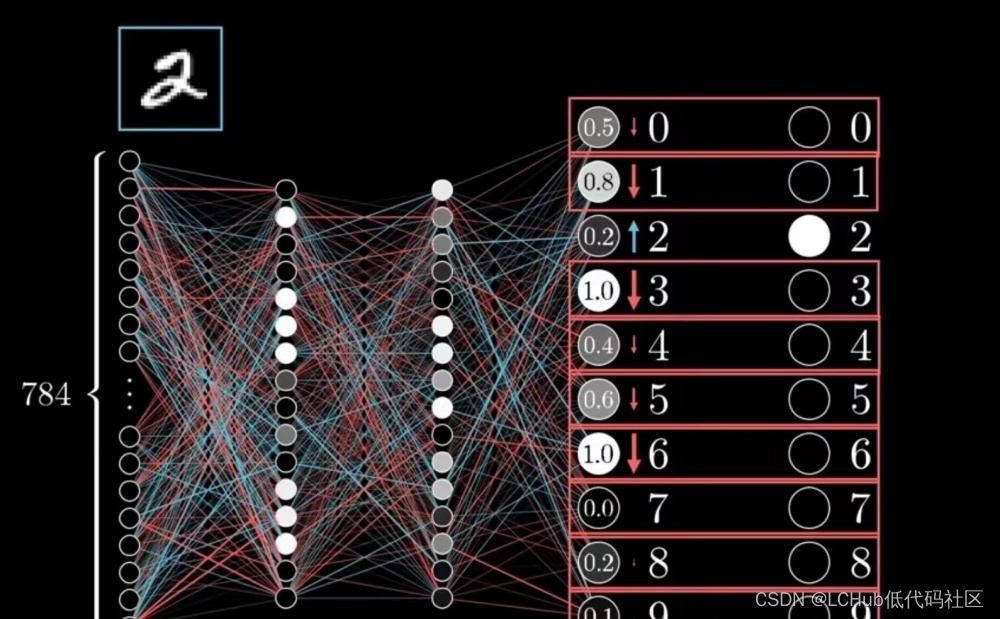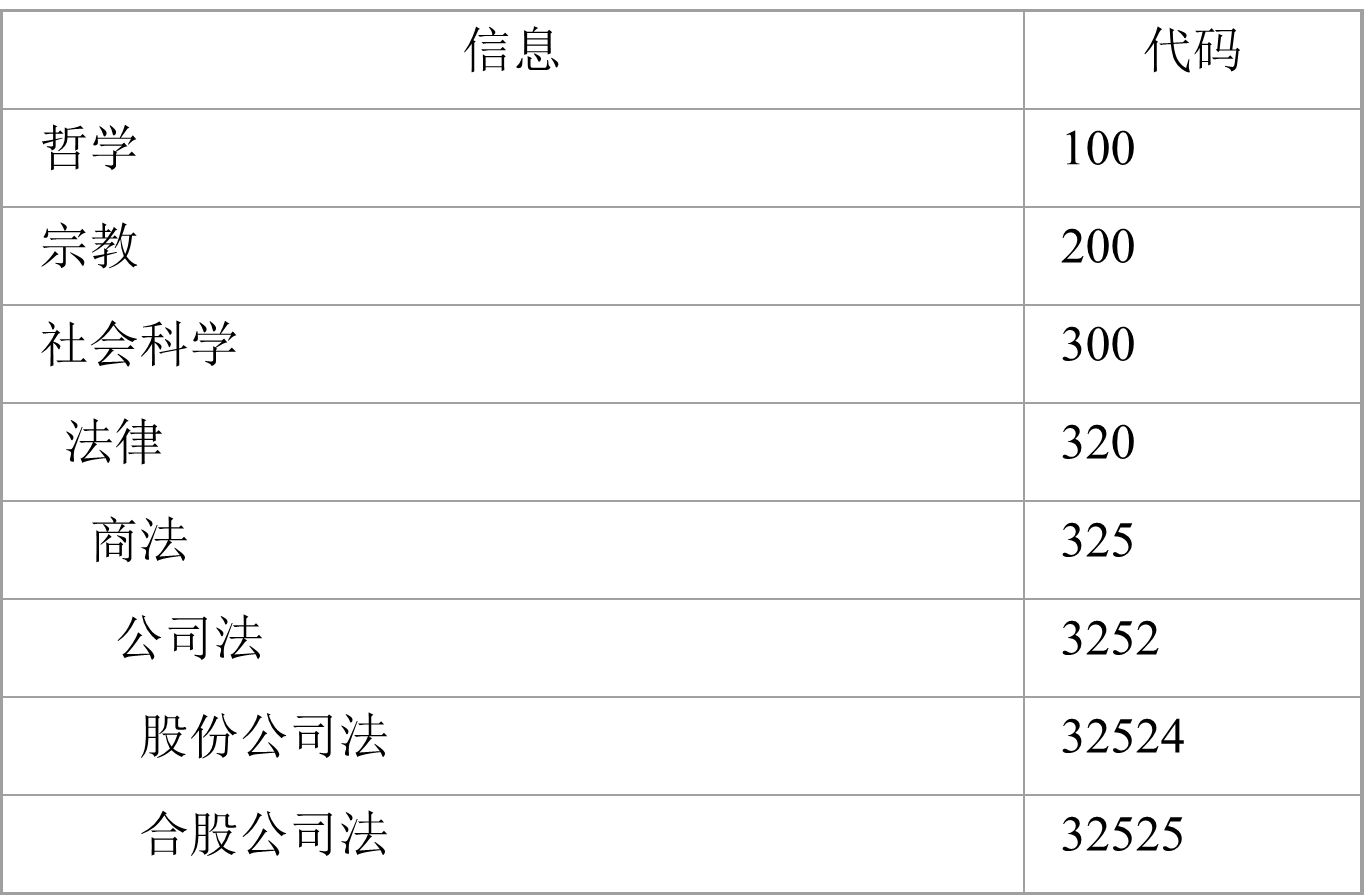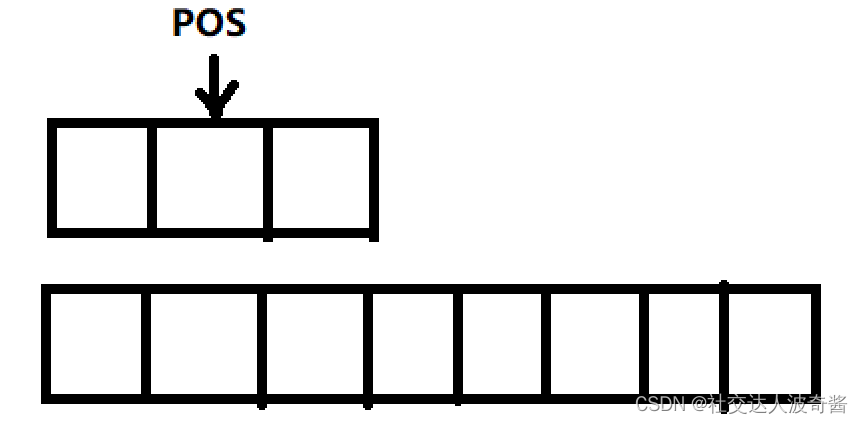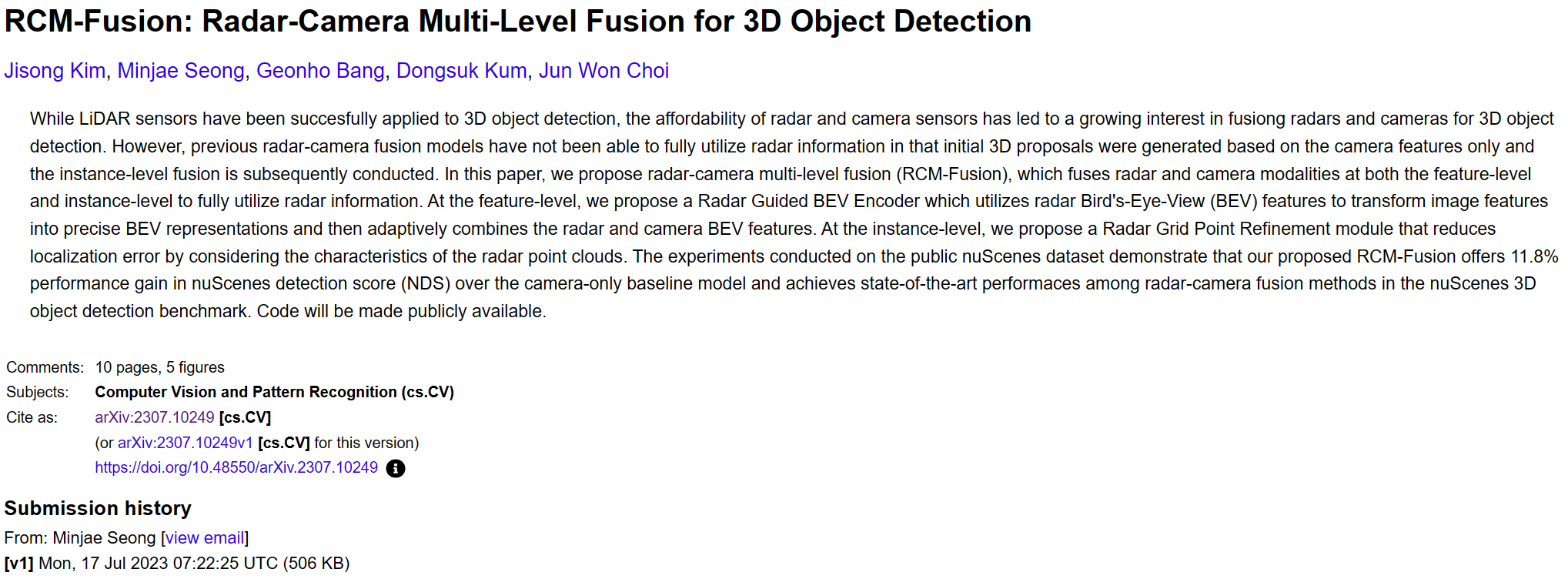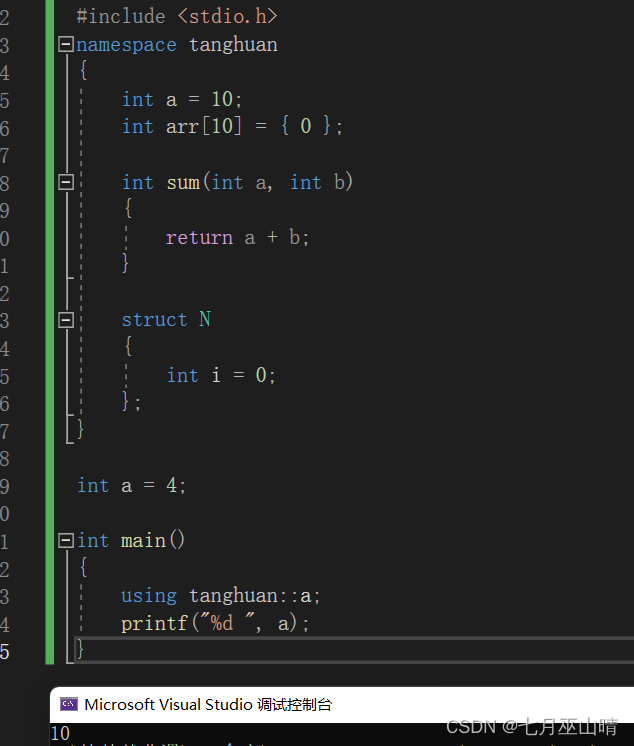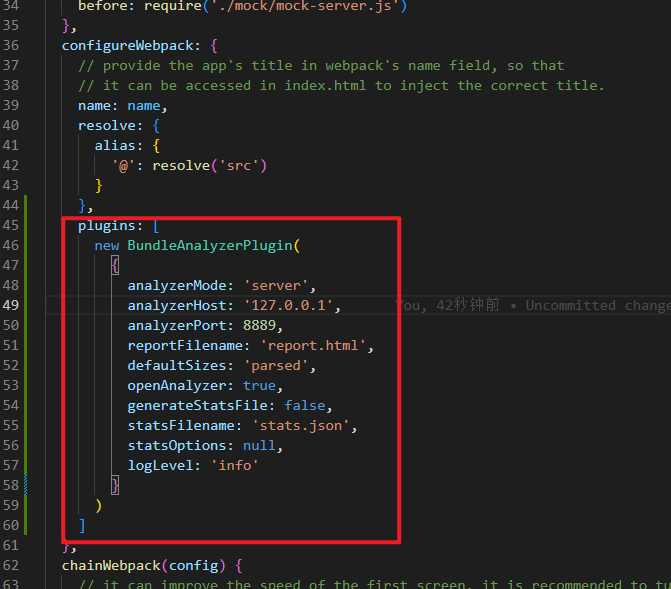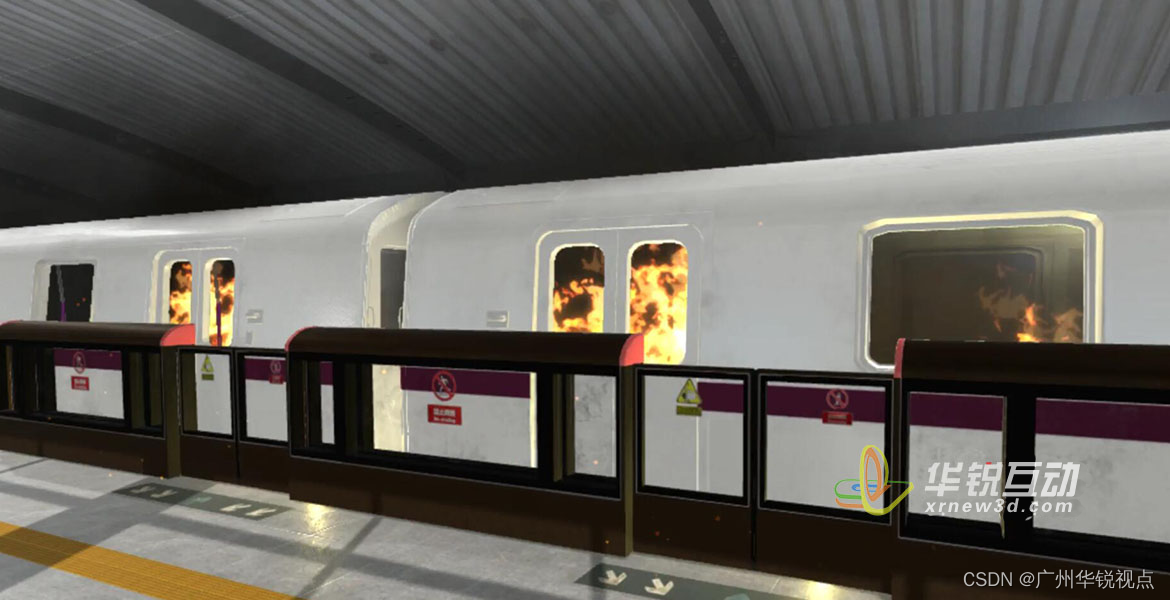文章目录
- 1.视频输出模块
- 1.1 视频输出初始化
- 1.1.1 视频输出初始化主要流程
- 1.1.2 calculate_display_rect初始化显示窗口大小
- 1.2 视频输出逻辑
- 1.2.1 event_loop开始处理SDL事件
- 1.2.2 video_refresh
- 1.2.2.1 计算上一帧显示时长,判断是否还要继续上一帧
- 1.2.2.2 估算当前帧显示时长,判断是否要丢帧
- 1.2.2.3 调用video_display进行显示
- 1.2.2.4 realloc_texture()重新分配vid_texture
- 1.2.2.5 sws_getCachedContext
- 1.2.2.6 sws_scale 图像转换
- 对于flags算法测试推荐文章:
1.视频输出模块
1.1 视频输出初始化
1.1.1 视频输出初始化主要流程
- 初始化SDL,SDL_Init,主要是SDL_INIT_VIDEO的支持
- SDL_CreateWindow,创建主窗口
- SDL_CreateRender,基于主窗口创建renderer,用于渲染输出
- stream_open
- event_loop,播放控制事件的相应循环,但也负责了video的显示输出
int main(int argc, char **argv)
{
/* 是否显示视频 */
if (display_disable) {
video_disable = 1;
}
// 3. SDL的初始化
flags = SDL_INIT_VIDEO | SDL_INIT_AUDIO | SDL_INIT_TIMER;
/* 是否运行音频 */
if (audio_disable)
flags &= ~SDL_INIT_AUDIO;
else {
/* Try to work around an occasional ALSA buffer underflow issue when the
* period size is NPOT due to ALSA resampling by forcing the buffer size. */
if (!SDL_getenv("SDL_AUDIO_ALSA_SET_BUFFER_SIZE"))
SDL_setenv("SDL_AUDIO_ALSA_SET_BUFFER_SIZE","1", 1);
}
if (display_disable)
flags &= ~SDL_INIT_VIDEO;
if (SDL_Init (flags)) {
av_log(NULL, AV_LOG_FATAL, "Could not initialize SDL - %s\n", SDL_GetError());
av_log(NULL, AV_LOG_FATAL, "(Did you set the DISPLAY variable?)\n");
exit(1);
}
SDL_EventState(SDL_SYSWMEVENT, SDL_IGNORE);
SDL_EventState(SDL_USEREVENT, SDL_IGNORE);
av_init_packet(&flush_pkt); // 初始化flush_packet
flush_pkt.data = (uint8_t *)&flush_pkt; // 初始化为数据指向自己本身
// 4. 创建窗口
if (!display_disable) {
int flags = SDL_WINDOW_HIDDEN;
if (alwaysontop)
#if SDL_VERSION_ATLEAST(2,0,5)
flags |= SDL_WINDOW_ALWAYS_ON_TOP;
#else
av_log(NULL, AV_LOG_WARNING, "Your SDL version doesn't support SDL_WINDOW_ALWAYS_ON_TOP. Feature will be inactive.\n");
#endif
if (borderless)
flags |= SDL_WINDOW_BORDERLESS;
else
flags |= SDL_WINDOW_RESIZABLE;
window = SDL_CreateWindow(program_name, SDL_WINDOWPOS_UNDEFINED, SDL_WINDOWPOS_UNDEFINED, default_width, default_height, flags);
SDL_SetHint(SDL_HINT_RENDER_SCALE_QUALITY, "linear");
if (window) {
// 创建renderer
renderer = SDL_CreateRenderer(window, -1, SDL_RENDERER_ACCELERATED | SDL_RENDERER_PRESENTVSYNC);
if (!renderer) {
av_log(NULL, AV_LOG_WARNING, "Failed to initialize a hardware accelerated renderer: %s\n", SDL_GetError());
renderer = SDL_CreateRenderer(window, -1, 0);
}
if (renderer) {
if (!SDL_GetRendererInfo(renderer, &renderer_info))
av_log(NULL, AV_LOG_VERBOSE, "Initialized %s renderer.\n", renderer_info.name);
}
}
if (!window || !renderer || !renderer_info.num_texture_formats) {
av_log(NULL, AV_LOG_FATAL, "Failed to create window or renderer: %s", SDL_GetError());
do_exit(NULL);
}
}
// 5. 通过stream_open函数,开启read_thread读取线程
is = stream_open(input_filename, file_iformat);
if (!is) {
av_log(NULL, AV_LOG_FATAL, "Failed to initialize VideoState!\n");
do_exit(NULL);
}
// 6. 事件响应
event_loop(is);
/* never returns */
return 0;
}
//7 从待处理流中获取相关参数,设置显示窗口的宽度、高度及宽高比
if (st_index[AVMEDIA_TYPE_VIDEO] >= 0) {
AVStream *st = ic->streams[st_index[AVMEDIA_TYPE_VIDEO]];
AVCodecParameters *codecpar = st->codecpar;
//根据流和帧宽高比猜测视频帧的像素宽高比(像素的宽高比,注意不是图像的)
AVRational sar = av_guess_sample_aspect_ratio(ic, st, NULL);
if (codecpar->width) {
// 设置显示窗口的大小和宽高比
set_default_window_size(codecpar->width, codecpar->height, sar);
}
}
这里重点讲解一下set_default_window_size函数
static void set_default_window_size(int width, int height, AVRational sar)
{
SDL_Rect rect;
int max_width = screen_width ? screen_width : INT_MAX; // 确定是否指定窗口最大宽度
int max_height = screen_height ? screen_height : INT_MAX; // 确定是否指定窗口最大高度
if (max_width == INT_MAX && max_height == INT_MAX)
max_height = height; // 没有指定最大高度时则使用视频的高度
calculate_display_rect(&rect, 0, 0, max_width, max_height, width, height, sar);
default_width = rect.w; // 实际是渲染区域的宽高
default_height = rect.h;
}
screen_width和screen_height可以在ffplay启动时用命令行进行设置 -x -y 如果没有指定那么就使用视频帧的高度
重点就是calculate_display_rect函数!
1.1.2 calculate_display_rect初始化显示窗口大小
static void calculate_display_rect(SDL_Rect *rect,
int scr_xleft, int scr_ytop, int scr_width, int scr_height,
int pic_width, int pic_height, AVRational pic_sar)
{
AVRational aspect_ratio = pic_sar; // 比率
int64_t width, height, x, y;
if (av_cmp_q(aspect_ratio, av_make_q(0, 1)) <= 0)
aspect_ratio = av_make_q(1, 1);// 如果aspect_ratio是负数或者为0,设置为1:1
// 转成真正的播放比例
aspect_ratio = av_mul_q(aspect_ratio, av_make_q(pic_width, pic_height));
/* XXX: we suppose the screen has a 1.0 pixel ratio */
// 计算显示视频帧区域的宽高
// 先以高度为基准
height = scr_height;
// &~1, 取偶数宽度 1110
width = av_rescale(height, aspect_ratio.num, aspect_ratio.den) & ~1;
if (width > scr_width) {
// 当以高度为基准,发现计算出来的需要的窗口宽度不足时调整为以窗口宽度为基准
width = scr_width;
height = av_rescale(width, aspect_ratio.den, aspect_ratio.num) & ~1;
}
// 计算显示视频帧区域的起始坐标(在显示窗口内部的区域)
x = (scr_width - width) / 2;
y = (scr_height - height) / 2;
rect->x = scr_xleft + x;
rect->y = scr_ytop + y;
rect->w = FFMAX((int)width, 1);
rect->h = FFMAX((int)height, 1);
}
这个函数设置了计算了窗口的宽高和位置
函数是先计算宽高比,如果宽高比没有设置的话则使用实际宽高来计算宽高比,然后先以高度为基准使用av_rescale函数计算宽度,如果宽度大于scr_width就转变为以宽度为基准.
然后就是计算顶点坐标了,scr_width和scr_height窗口大小,width和heigth是视频大小,我们要计算出视频的左上角位置
看图:
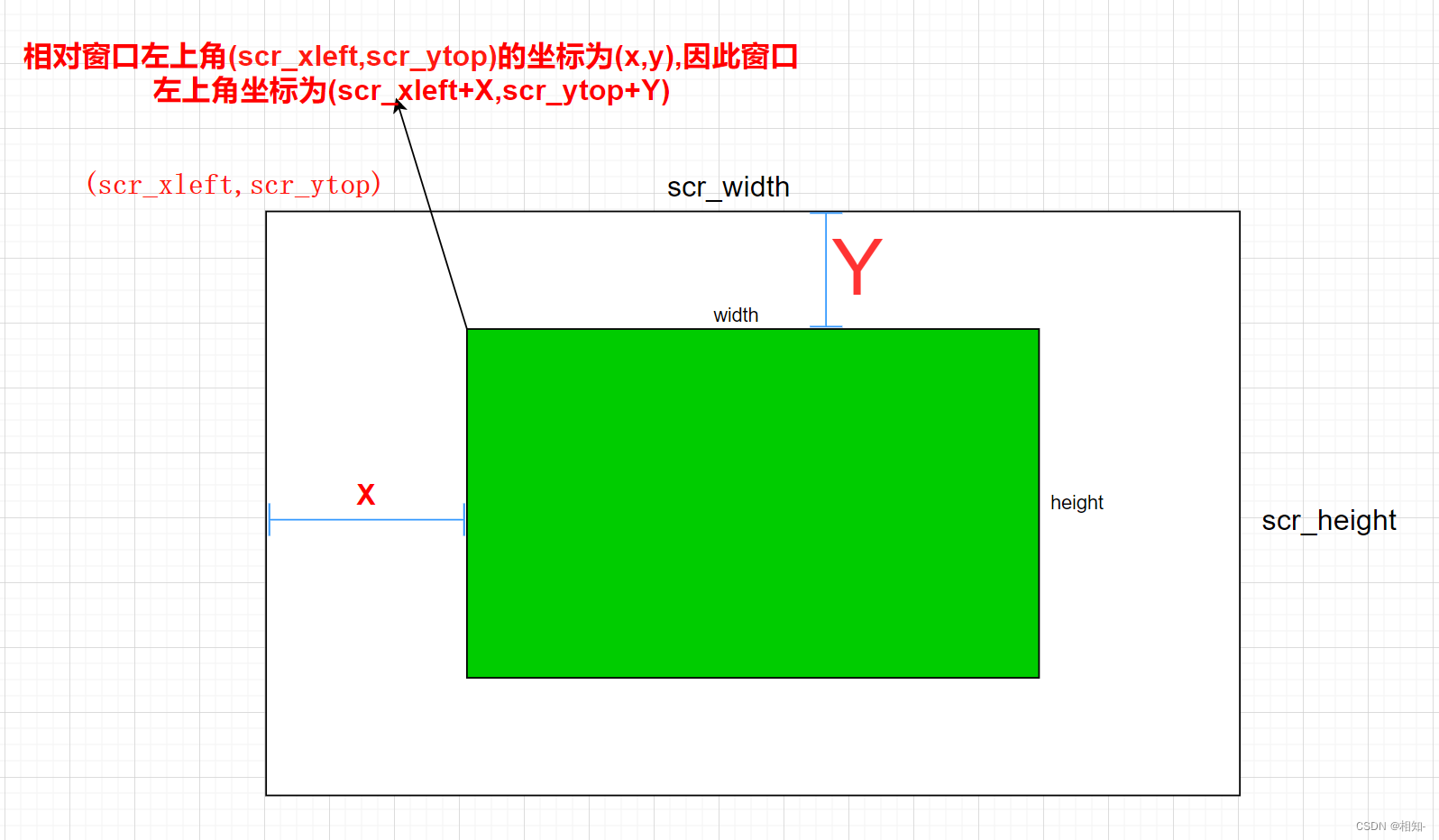
代码中rect就是渲染的视频部分,也就是图中绿色部分!
1.2 视频输出逻辑
main()->
event_loop()->
refresh_loop_wait_event()->
video_refresh()->
video_display()->
video_image_display()->
upload_texture()
1.2.1 event_loop开始处理SDL事件
static void event_loop(VideoState *cur_stream)
{
SDL_Event event;
double incr, pos, frac;
for (;;) {
double x;
refresh_loop_wait_event(cur_stream, &event); //video是在这里显示的
switch (event.type) {
case SDL_KEYDOWN: /* 键盘事件 */
if (exit_on_keydown || event.key.keysym.sym == SDLK_ESCAPE || event.key.keysym.sym == SDLK_q) {
do_exit(cur_stream);
break;
}
if (!cur_stream->width)
continue;
switch (event.key.keysym.sym) {
case SDLK_f:
toggle_full_screen(cur_stream);
cur_stream->force_refresh = 1;
break;
case SDLK_p:
case SDLK_SPACE: //按空格键触发暂停/恢复
toggle_pause(cur_stream);
break;
case SDLK_m:
toggle_mute(cur_stream);
break;
case SDLK_KP_MULTIPLY:
case SDLK_0:
update_volume(cur_stream, 1, SDL_VOLUME_STEP);
break;
case SDLK_KP_DIVIDE:
case SDLK_9:
update_volume(cur_stream, -1, SDL_VOLUME_STEP);
break;
case SDLK_s: // S: Step to next frame
step_to_next_frame(cur_stream);
break;
case SDLK_a:
stream_cycle_channel(cur_stream, AVMEDIA_TYPE_AUDIO);
break;
case SDLK_v:
stream_cycle_channel(cur_stream, AVMEDIA_TYPE_VIDEO);
break;
case SDLK_c:
stream_cycle_channel(cur_stream, AVMEDIA_TYPE_VIDEO);
stream_cycle_channel(cur_stream, AVMEDIA_TYPE_AUDIO);
stream_cycle_channel(cur_stream, AVMEDIA_TYPE_SUBTITLE);
break;
case SDLK_t:
stream_cycle_channel(cur_stream, AVMEDIA_TYPE_SUBTITLE);
break;
case SDLK_w:
#if CONFIG_AVFILTER
if (cur_stream->show_mode == SHOW_MODE_VIDEO && cur_stream->vfilter_idx < nb_vfilters - 1) {
if (++cur_stream->vfilter_idx >= nb_vfilters)
cur_stream->vfilter_idx = 0;
} else {
cur_stream->vfilter_idx = 0;
toggle_audio_display(cur_stream);
}
#else
toggle_audio_display(cur_stream);
#endif
break;
case SDLK_PAGEUP:
if (cur_stream->ic->nb_chapters <= 1) {
incr = 600.0;
goto do_seek;
}
seek_chapter(cur_stream, 1);
break;
case SDLK_PAGEDOWN:
if (cur_stream->ic->nb_chapters <= 1) {
incr = -600.0;
goto do_seek;
}
seek_chapter(cur_stream, -1);
break;
case SDLK_LEFT:
incr = seek_interval ? -seek_interval : -10.0;
goto do_seek;
case SDLK_RIGHT:
incr = seek_interval ? seek_interval : 10.0;
goto do_seek;
case SDLK_UP:
incr = 60.0;
goto do_seek;
case SDLK_DOWN:
incr = -60.0;
do_seek:
if (seek_by_bytes) {
pos = -1;
if (pos < 0 && cur_stream->video_stream >= 0)
pos = frame_queue_last_pos(&cur_stream->pictq);
if (pos < 0 && cur_stream->audio_stream >= 0)
pos = frame_queue_last_pos(&cur_stream->sampq);
if (pos < 0)
pos = avio_tell(cur_stream->ic->pb);
if (cur_stream->ic->bit_rate)
incr *= cur_stream->ic->bit_rate / 8.0;
else
incr *= 180000.0;
pos += incr;
stream_seek(cur_stream, pos, incr, 1);
} else {
pos = get_master_clock(cur_stream);
if (isnan(pos))
pos = (double)cur_stream->seek_pos / AV_TIME_BASE;
pos += incr; // 现在是秒的单位
if (cur_stream->ic->start_time != AV_NOPTS_VALUE && pos < cur_stream->ic->start_time / (double)AV_TIME_BASE)
pos = cur_stream->ic->start_time / (double)AV_TIME_BASE;
stream_seek(cur_stream, (int64_t)(pos * AV_TIME_BASE), (int64_t)(incr * AV_TIME_BASE), 0);
}
break;
default:
break;
}
break;
case SDL_MOUSEBUTTONDOWN: /* 鼠标按下事件 */
if (exit_on_mousedown) {
do_exit(cur_stream);
break;
}
if (event.button.button == SDL_BUTTON_LEFT) {
static int64_t last_mouse_left_click = 0;
if (av_gettime_relative() - last_mouse_left_click <= 500000) {
//连续鼠标左键点击2次显示窗口间隔小于0.5秒,则进行全屏或者恢复原始窗口
toggle_full_screen(cur_stream);
cur_stream->force_refresh = 1;
last_mouse_left_click = 0;
} else {
last_mouse_left_click = av_gettime_relative();
}
}
case SDL_MOUSEMOTION: /* 鼠标移动事件 */
if (cursor_hidden) {
SDL_ShowCursor(1);
cursor_hidden = 0;
}
cursor_last_shown = av_gettime_relative();
if (event.type == SDL_MOUSEBUTTONDOWN) {
if (event.button.button != SDL_BUTTON_RIGHT)
break;
x = event.button.x;
} else {
if (!(event.motion.state & SDL_BUTTON_RMASK))
break;
x = event.motion.x;
}
if (seek_by_bytes || cur_stream->ic->duration <= 0) {
uint64_t size = avio_size(cur_stream->ic->pb); // 整个文件的字节
stream_seek(cur_stream, size*x/cur_stream->width, 0, 1);
} else {
int64_t ts;
int ns, hh, mm, ss;
int tns, thh, tmm, tss;
tns = cur_stream->ic->duration / 1000000LL;
thh = tns / 3600;
tmm = (tns % 3600) / 60;
tss = (tns % 60);
frac = x / cur_stream->width;
ns = frac * tns;
hh = ns / 3600;
mm = (ns % 3600) / 60;
ss = (ns % 60);
av_log(NULL, AV_LOG_INFO,
"Seek to %2.0f%% (%2d:%02d:%02d) of total duration (%2d:%02d:%02d) \n", frac*100,
hh, mm, ss, thh, tmm, tss);
ts = frac * cur_stream->ic->duration;
if (cur_stream->ic->start_time != AV_NOPTS_VALUE)
ts += cur_stream->ic->start_time;
stream_seek(cur_stream, ts, 0, 0);
}
break;
case SDL_WINDOWEVENT: /* 窗口事件 */
switch (event.window.event) {
case SDL_WINDOWEVENT_SIZE_CHANGED:
screen_width = cur_stream->width = event.window.data1;
screen_height = cur_stream->height = event.window.data2;
if (cur_stream->vis_texture) {
SDL_DestroyTexture(cur_stream->vis_texture);
cur_stream->vis_texture = NULL;
}
case SDL_WINDOWEVENT_EXPOSED:
cur_stream->force_refresh = 1;
}
break;
case SDL_QUIT:
case FF_QUIT_EVENT: /* ffplay自定义事件,用于主动退出 */
do_exit(cur_stream);
break;
default:
break;
}
}
}
这个函数主要是通过refresh_loop_wait_event函数等待事件,然后event_loop进行处理事件.
video的显示主要在refresh_loop_wait_event中:
static void refresh_loop_wait_event(VideoState *is, SDL_Event *event) {
double remaining_time = 0.0; /* 休眠等待,remaining_time的计算在video_refresh中 */
/* 调用SDL_PeepEvents前先调用SDL_PumpEvents,将输入设备的事件抽到事件队列中 */
SDL_PumpEvents();
/*
* SDL_PeepEvents check是否事件,比如鼠标移入显示区等
* 从事件队列中拿一个事件,放到event中,如果没有事件,则进入循环中
* SDL_PeekEvents用于读取事件,在调用该函数之前,必须调用SDL_PumpEvents搜集键盘等事件
*/
while (!SDL_PeepEvents(event, 1, SDL_GETEVENT, SDL_FIRSTEVENT, SDL_LASTEVENT)) {
if (!cursor_hidden && av_gettime_relative() - cursor_last_shown > CURSOR_HIDE_DELAY) {
SDL_ShowCursor(0);
cursor_hidden = 1;
}
/*
* remaining_time就是用来进行音视频同步的。
* 在video_refresh函数中,根据当前帧显示时刻(display time)和实际时刻(actual time)
* 计算需要sleep的时间,保证帧按时显示
*/
if (remaining_time > 0.0) //sleep控制画面输出的时机
av_usleep((int64_t)(remaining_time * 1000000.0)); // remaining_time <= REFRESH_RATE
remaining_time = REFRESH_RATE;
if (is->show_mode != SHOW_MODE_NONE && // 显示模式不等于SHOW_MODE_NONE
(!is->paused // 非暂停状态
|| is->force_refresh) // 强制刷新状态
) {
video_refresh(is, &remaining_time);
}
/* 从输入设备中搜集事件,推动这些事件进入事件队列,更新事件队列的状态,
* 不过它还有一个作用是进行视频子系统的设备状态更新,如果不调用这个函数,
* 所显示的视频会在大约10秒后丢失色彩。没有调用SDL_PumpEvents,将不会
* 有任何的输入设备事件进入队列,这种情况下,SDL就无法响应任何的键盘等硬件输入。
*/
SDL_PumpEvents();
}
}
SDL_PeepEvent通过SDL_GETEVENT非阻塞查询队列中是否有事件,如果不为0则有事件发生(-1表示发生错误),那么函数就会返回,让event_loop进行处理;否则调用video_refresh进行显示画面,并且通过输出参数remaining_time获取下一轮应当sleep的时间以保证画面稳定输出.
是否调用video_refresh的前置条件为:
- 显示模式不为SHOW_MODE_NONE(如果只包含audio的画,也可能为其波形图)
- 当前没有被暂停
- 当设置了force_refresh(强制刷新),分析一下出现的情况:
- video_refresh里面帧显示,常规情况.
- SDL_WINDOWEVENT_EXPOSED,窗口需要重新绘制
- SDL_MOUSEBUTTONDOWN && SDL_BUTTON_LEFT 鼠标按下并且按左键连续间隔小于0.5s
- SDLK_f,按f键进行全屏或者恢复原始播放窗口
有可能理解不了这个强制刷新是什么,看一下没有强制刷新的效果图:
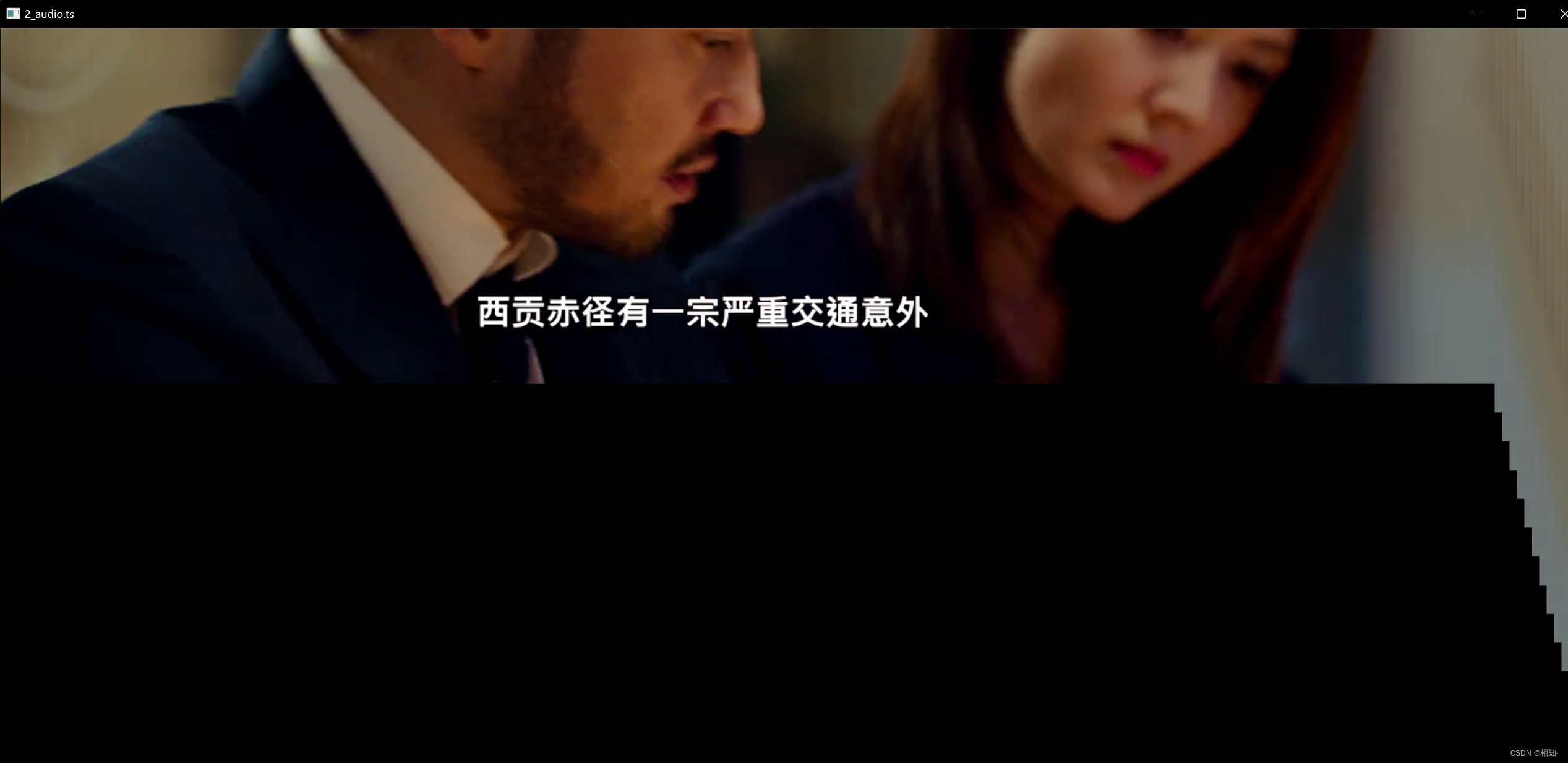
可见下面一部分残缺了,因为我们改变了窗口大小,但是我们渲染的页面没有改变,这时我们重新刷新一下可以放渲染页面跟着窗口大小进行改变
1.2.2 video_refresh
static void video_refresh(void *opaque, double *remaining_time)
{
VideoState *is = opaque;
double time;
Frame *sp, *sp2;
if (!is->paused && get_master_sync_type(is) == AV_SYNC_EXTERNAL_CLOCK && is->realtime)
check_external_clock_speed(is);
if (!display_disable && is->show_mode != SHOW_MODE_VIDEO && is->audio_st) {
time = av_gettime_relative() / 1000000.0;
if (is->force_refresh || is->last_vis_time + rdftspeed < time) {
video_display(is);
is->last_vis_time = time;
}
*remaining_time = FFMIN(*remaining_time, is->last_vis_time + rdftspeed - time);
}
if (is->video_st) {
retry:
if (frame_queue_nb_remaining(&is->pictq) == 0) {// 帧队列是否为空
// nothing to do, no picture to display in the queue
// 什么都不做,队列中没有图像可显示
} else { // 重点是音视频同步
double last_duration, duration, delay;
Frame *vp, *lastvp;
/* dequeue the picture */
// 从队列取出上一个Frame
lastvp = frame_queue_peek_last(&is->pictq);//读取上一帧
vp = frame_queue_peek(&is->pictq); // 读取待显示帧
// lastvp 上一帧(正在显示的帧)
// vp 等待显示的帧
if (vp->serial != is->videoq.serial) {
// 如果不是最新的播放序列,则将其出队列,以尽快读取最新序列的帧
frame_queue_next(&is->pictq);
goto retry;
}
if (lastvp->serial != vp->serial) {
// 新的播放序列重置当前时间
is->frame_timer = av_gettime_relative() / 1000000.0;
}
if (is->paused)
{
goto display;
printf("视频暂停is->paused");
}
/* compute nominal last_duration */
//lastvp上一帧,vp当前帧 ,nextvp下一帧
//last_duration 计算上一帧应显示的时长
last_duration = vp_duration(is, lastvp, vp);
// 经过compute_target_delay方法,计算出待显示帧vp需要等待的时间
// 如果以video同步,则delay直接等于last_duration。
// 如果以audio或外部时钟同步,则需要比对主时钟调整待显示帧vp要等待的时间。
delay = compute_target_delay(last_duration, is); // 上一帧需要维持的时间
time= av_gettime_relative()/1000000.0;
// is->frame_timer 实际上就是上一帧lastvp的播放时间,
// is->frame_timer + delay 是待显示帧vp该播放的时间
if (time < is->frame_timer + delay) { //判断是否继续显示上一帧
// 当前系统时刻还未到达上一帧的结束时刻,那么还应该继续显示上一帧。
// 计算出最小等待时间
*remaining_time = FFMIN(is->frame_timer + delay - time, *remaining_time);
goto display;
}
// 走到这一步,说明已经到了或过了该显示的时间,待显示帧vp的状态变更为当前要显示的帧
is->frame_timer += delay; // 更新当前帧播放的时间
if (delay > 0 && time - is->frame_timer > AV_SYNC_THRESHOLD_MAX) {
is->frame_timer = time; //如果和系统时间差距太大,就纠正为系统时间
}
SDL_LockMutex(is->pictq.mutex);
if (!isnan(vp->pts))
update_video_pts(is, vp->pts, vp->pos, vp->serial); // 更新video时钟
SDL_UnlockMutex(is->pictq.mutex);
//丢帧逻辑
if (frame_queue_nb_remaining(&is->pictq) > 1) {//有nextvp才会检测是否该丢帧
Frame *nextvp = frame_queue_peek_next(&is->pictq);
duration = vp_duration(is, vp, nextvp);
if(!is->step // 非逐帧模式才检测是否需要丢帧 is->step==1 为逐帧播放
&& (framedrop>0 || // cpu解帧过慢
(framedrop && get_master_sync_type(is) != AV_SYNC_VIDEO_MASTER)) // 非视频同步方式
&& time > is->frame_timer + duration // 确实落后了一帧数据
) {
printf("%s(%d) dif:%lfs, drop frame\n", __FUNCTION__, __LINE__,
(is->frame_timer + duration) - time);
is->frame_drops_late++; // 统计丢帧情况
frame_queue_next(&is->pictq); // 这里实现真正的丢帧
//(这里不能直接while丢帧,因为很可能audio clock重新对时了,这样delay值需要重新计算)
goto retry; //回到函数开始位置,继续重试
}
}
if (is->subtitle_st) {
while (frame_queue_nb_remaining(&is->subpq) > 0) {
sp = frame_queue_peek(&is->subpq);
if (frame_queue_nb_remaining(&is->subpq) > 1)
sp2 = frame_queue_peek_next(&is->subpq);
else
sp2 = NULL;
if (sp->serial != is->subtitleq.serial
|| (is->vidclk.pts > (sp->pts + ((float) sp->sub.end_display_time / 1000)))
|| (sp2 && is->vidclk.pts > (sp2->pts + ((float) sp2->sub.start_display_time / 1000))))
{
if (sp->uploaded) {
int i;
for (i = 0; i < sp->sub.num_rects; i++) {
AVSubtitleRect *sub_rect = sp->sub.rects[i];
uint8_t *pixels;
int pitch, j;
if (!SDL_LockTexture(is->sub_texture, (SDL_Rect *)sub_rect, (void **)&pixels, &pitch)) {
for (j = 0; j < sub_rect->h; j++, pixels += pitch)
memset(pixels, 0, sub_rect->w << 2);
SDL_UnlockTexture(is->sub_texture);
}
}
}
frame_queue_next(&is->subpq);
} else {
break;
}
}
}
frame_queue_next(&is->pictq); // 当前vp帧出队列
is->force_refresh = 1; /* 说明需要刷新视频帧 */
if (is->step && !is->paused)
stream_toggle_pause(is); // 逐帧的时候那继续进入暂停状态
}
display:
/* display picture */
if (!display_disable && is->force_refresh && is->show_mode == SHOW_MODE_VIDEO && is->pictq.rindex_shown)
video_display(is); // 重点是显示
}
is->force_refresh = 0;
if (show_status) {
static int64_t last_time;
int64_t cur_time;
int aqsize, vqsize, sqsize;
double av_diff;
cur_time = av_gettime_relative();
if (!last_time || (cur_time - last_time) >= 30000) {
aqsize = 0;
vqsize = 0;
sqsize = 0;
if (is->audio_st)
aqsize = is->audioq.size;
if (is->video_st)
vqsize = is->videoq.size;
if (is->subtitle_st)
sqsize = is->subtitleq.size;
av_diff = 0;
if (is->audio_st && is->video_st)
av_diff = get_clock(&is->audclk) - get_clock(&is->vidclk);
else if (is->video_st)
av_diff = get_master_clock(is) - get_clock(&is->vidclk);
else if (is->audio_st)
av_diff = get_master_clock(is) - get_clock(&is->audclk);
av_log(NULL, AV_LOG_INFO,
"%7.2f %s:%7.3f fd=%4d aq=%5dKB vq=%5dKB sq=%5dB f=%"PRId64"/%"PRId64" \r",
get_master_clock(is),
(is->audio_st && is->video_st) ? "A-V" : (is->video_st ? "M-V" : (is->audio_st ? "M-A" : " ")),
av_diff,
is->frame_drops_early + is->frame_drops_late,
aqsize / 1024,
vqsize / 1024,
sqsize,
is->video_st ? is->viddec.avctx->pts_correction_num_faulty_dts : 0,
is->video_st ? is->viddec.avctx->pts_correction_num_faulty_pts : 0);
fflush(stdout);
last_time = cur_time;
}
}
}
流程图:

看主流程图:
- 取出上一帧和待显示的帧
- 计算上一帧显示的时长,判断当前是否继续上一帧
- 估算当前帧显示时长,判断是否要丢帧
- 调用video_display显示
1.2.2.1 计算上一帧显示时长,判断是否还要继续上一帧
首先判断pictq是否为空(调用frame_queue_nb_remaining判断是否还有未显示的帧),如果为空则继续调用video_display显示上一帧
在进一步计算上一帧显示时间之前,需要先判断下一帧vp是否为最新序列,也就是说if(vp->serial!= is->videoq.serial),如果条件成立就是发生过seek等操作,此时应该丢弃lastvp. 故调用frame_queue_next抛弃lastvp后,返回流程开头重试.
接下来 可以计算lastvp显示时长了. 计算代码为:
last_duration = vp_duration(is, lastvp, vp);
delay = compute_target_delay(last_duration, is);//返回当前显示帧要持续播放的时间
本质就是通过上一帧和待显示帧pts来计算的,如果考虑到同步,则还需要考虑当前与主时钟的差距来决定是重复上一帧,还是丢帧,还是正常显示下一帧(待显示帧)
time= av_gettime_relative()/1000000.0;
// is->frame_timer 实际上就是上一帧lastvp的播放时间,
// is->frame_timer + delay 是待显示帧vp该播放的时间
if (time < is->frame_timer + delay) { //判断是否继续显示上一帧
// 当前系统时刻还未到达上一帧的结束时刻,那么还应该继续显示上一帧。
// 计算出最小等待时间
*remaining_time = FFMIN(is->frame_timer + delay - time, *remaining_time);
goto display;
}
frame_timer就是当前帧显示时间,如果当前帧显示时间+delay显示时间大于当前系统时间的话就继续显示上一帧!

1.2.2.2 估算当前帧显示时长,判断是否要丢帧
is->frame_timer += delay; // 更新当前帧播放的时间
if (delay > 0 && time - is->frame_timer > AV_SYNC_THRESHOLD_MAX) {
is->frame_timer = time; //如果和系统时间差距太大,就纠正为系统时间
}
判断是否需要丢帧
if (frame_queue_nb_remaining(&is->pictq) > 1) {//有nextvp才会检测是否该丢帧
Frame *nextvp = frame_queue_peek_next(&is->pictq);
duration = vp_duration(is, vp, nextvp);
if(!is->step // 非逐帧模式才检测是否需要丢帧 is->step==1 为逐帧播放
&& (framedrop>0 || // cpu解帧过慢
(framedrop && get_master_sync_type(is) != AV_SYNC_VIDEO_MASTER)) // 非视频同步方式
&& time > is->frame_timer + duration // 确实落后了一帧数据
) {
printf("%s(%d) dif:%lfs, drop frame\n", __FUNCTION__, __LINE__,
(is->frame_timer + duration) - time);
is->frame_drops_late++; // 统计丢帧情况
frame_queue_next(&is->pictq); // 这里实现真正的丢帧
//(这里不能直接while丢帧,因为很可能audio clock重新对时了,这样delay值需要重新计算)
goto retry; //回到函数开始位置,继续重试
}
}
通过待显示帧和下一帧来计算当前帧显示时间(前提是得有下一帧)
并且要符合以下条件才会丢帧:
- 不处于step状态,逐帧状态
- 启动framedrop模式,也就是cpu过慢时需要丢帧,并且不是以video为同步时钟的情况下
- 当前时间已经>frame_timer+duration
1.2.2.3 调用video_display进行显示
static void video_display(VideoState *is)
{
if (!is->width)
video_open(is); //如果窗口未显示,则显示窗口
SDL_SetRenderDrawColor(renderer, 0, 0, 0, 255);
SDL_RenderClear(renderer);
if (is->audio_st && is->show_mode != SHOW_MODE_VIDEO)
video_audio_display(is); //图形化显示仅有音轨的文件
else if (is->video_st)
video_image_display(is); //显示一帧视频画面
SDL_RenderPresent(renderer);
}
static void video_image_display(VideoState *is)
{
Frame *vp;
Frame *sp = NULL;
SDL_Rect rect;
// keep_last的作用就出来了,我们是有调用frame_queue_next, 但最近出队列的帧并没有真正销毁
// 所以这里可以读取出来显示
vp = frame_queue_peek_last(&is->pictq); //
if (is->subtitle_st) {
if (frame_queue_nb_remaining(&is->subpq) > 0) {
sp = frame_queue_peek(&is->subpq);
if (vp->pts >= sp->pts + ((float) sp->sub.start_display_time / 1000)) {
if (!sp->uploaded) {
uint8_t* pixels[4];
int pitch[4];
int i;
if (!sp->width || !sp->height) {
sp->width = vp->width;
sp->height = vp->height;
}
if (realloc_texture(&is->sub_texture, SDL_PIXELFORMAT_ARGB8888, sp->width, sp->height, SDL_BLENDMODE_BLEND, 1) < 0)
return;
for (i = 0; i < sp->sub.num_rects; i++) {
AVSubtitleRect *sub_rect = sp->sub.rects[i];
sub_rect->x = av_clip(sub_rect->x, 0, sp->width );
sub_rect->y = av_clip(sub_rect->y, 0, sp->height);
sub_rect->w = av_clip(sub_rect->w, 0, sp->width - sub_rect->x);
sub_rect->h = av_clip(sub_rect->h, 0, sp->height - sub_rect->y);
is->sub_convert_ctx = sws_getCachedContext(is->sub_convert_ctx,
sub_rect->w, sub_rect->h, AV_PIX_FMT_PAL8,
sub_rect->w, sub_rect->h, AV_PIX_FMT_BGRA,
0, NULL, NULL, NULL);
if (!is->sub_convert_ctx) {
av_log(NULL, AV_LOG_FATAL, "Cannot initialize the conversion context\n");
return;
}
if (!SDL_LockTexture(is->sub_texture, (SDL_Rect *)sub_rect, (void **)pixels, pitch)) {
sws_scale(is->sub_convert_ctx, (const uint8_t * const *)sub_rect->data, sub_rect->linesize,
0, sub_rect->h, pixels, pitch);
SDL_UnlockTexture(is->sub_texture);
}
}
sp->uploaded = 1;
}
} else
sp = NULL;
}
}
//将帧宽高按照sar最大适配到窗口,并通过rect返回视频帧在窗口的显示位置和宽高
calculate_display_rect(&rect, is->xleft, is->ytop, is->width, is->height,
vp->width, vp->height, vp->sar);
// rect.x = rect.w /2; // 测试
// rect.w = rect.w /2; // 缩放实际不是用sws, 缩放是sdl去做的
if (!vp->uploaded) {
// 把yuv数据更新到vid_texture
if (upload_texture(&is->vid_texture, vp->frame, &is->img_convert_ctx) < 0)
return;
vp->uploaded = 1;
vp->flip_v = vp->frame->linesize[0] < 0;
}
set_sdl_yuv_conversion_mode(vp->frame);
SDL_RenderCopyEx(renderer, is->vid_texture, NULL, &rect, 0, NULL, vp->flip_v ? SDL_FLIP_VERTICAL : 0);
set_sdl_yuv_conversion_mode(NULL);
if (sp) {
#if USE_ONEPASS_SUBTITLE_RENDER
SDL_RenderCopy(renderer, is->sub_texture, NULL, &rect);
#else
int i;
double xratio = (double)rect.w / (double)sp->width;
double yratio = (double)rect.h / (double)sp->height;
for (i = 0; i < sp->sub.num_rects; i++) {
SDL_Rect *sub_rect = (SDL_Rect*)sp->sub.rects[i];
SDL_Rect target = {.x = rect.x + sub_rect->x * xratio,
.y = rect.y + sub_rect->y * yratio,
.w = sub_rect->w * xratio,
.h = sub_rect->h * yratio};
SDL_RenderCopy(renderer, is->sub_texture, sub_rect, &target);
}
#endif
}
}
video_image_display整体不算复杂,每次渲染都会调用calculate_display_rect进行重新计算显示窗口等
最主要的显示是调用upload_texture将AVFrame的图像数据传给sdl的纹理进行渲染:
static int upload_texture(SDL_Texture **tex, AVFrame *frame, struct SwsContext **img_convert_ctx) {
int ret = 0;
Uint32 sdl_pix_fmt;
SDL_BlendMode sdl_blendmode;
// 根据frame中的图像格式(FFmpeg像素格式),获取对应的SDL像素格式和blendmode
get_sdl_pix_fmt_and_blendmode(frame->format, &sdl_pix_fmt, &sdl_blendmode);
// 参数tex实际是&is->vid_texture,此处根据得到的SDL像素格式,为&is->vid_texture
if (realloc_texture(tex, sdl_pix_fmt == SDL_PIXELFORMAT_UNKNOWN ? SDL_PIXELFORMAT_ARGB8888 : sdl_pix_fmt,
frame->width, frame->height, sdl_blendmode, 0) < 0)
return -1;
//根据sdl_pix_fmt从AVFrame中取数据填充纹理
switch (sdl_pix_fmt) {
// frame格式是SDL不支持的格式,则需要进行图像格式转换,转换为目标格式AV_PIX_FMT_BGRA,
// 对应SDL_PIXELFORMAT_BGRA32
case SDL_PIXELFORMAT_UNKNOWN:
/* This should only happen if we are not using avfilter... */
*img_convert_ctx = sws_getCachedContext(*img_convert_ctx,
frame->width, frame->height, frame->format,
frame->width, frame->height, AV_PIX_FMT_BGRA,
sws_flags, NULL, NULL, NULL);
if (*img_convert_ctx != NULL) {
uint8_t *pixels[4]; // 之前取Texture的缓存
int pitch[4];
if (!SDL_LockTexture(*tex, NULL, (void **)pixels, pitch)) {
sws_scale(*img_convert_ctx, (const uint8_t * const *)frame->data, frame->linesize,
0, frame->height, pixels, pitch);
SDL_UnlockTexture(*tex);
}
} else {
av_log(NULL, AV_LOG_FATAL, "Cannot initialize the conversion context\n");
ret = -1;
}
break;
// frame格式对应SDL_PIXELFORMAT_IYUV,不用进行图像格式转换,调用SDL_UpdateYUVTexture()更新SDL texture
case SDL_PIXELFORMAT_IYUV:
if (frame->linesize[0] > 0 && frame->linesize[1] > 0 && frame->linesize[2] > 0) {
ret = SDL_UpdateYUVTexture(*tex, NULL, frame->data[0], frame->linesize[0],
frame->data[1], frame->linesize[1],
frame->data[2], frame->linesize[2]);
} else if (frame->linesize[0] < 0 && frame->linesize[1] < 0 && frame->linesize[2] < 0) {
ret = SDL_UpdateYUVTexture(*tex, NULL, frame->data[0] + frame->linesize[0] * (frame->height - 1), -frame->linesize[0],
frame->data[1] + frame->linesize[1] * (AV_CEIL_RSHIFT(frame->height, 1) - 1), -frame->linesize[1],
frame->data[2] + frame->linesize[2] * (AV_CEIL_RSHIFT(frame->height, 1) - 1), -frame->linesize[2]);
} else {
av_log(NULL, AV_LOG_ERROR, "Mixed negative and positive linesizes are not supported.\n");
return -1;
}
break;
// frame格式对应其他SDL像素格式,不用进行图像格式转换,调用SDL_UpdateTexture()更新SDL texture
default:
if (frame->linesize[0] < 0) {
ret = SDL_UpdateTexture(*tex, NULL, frame->data[0] + frame->linesize[0] * (frame->height - 1), -frame->linesize[0]);
} else {
ret = SDL_UpdateTexture(*tex, NULL, frame->data[0], frame->linesize[0]);
}
break;
}
return ret;
}
frame中的像素格式是FFmpeg中定义的像素格式,FFmpeg中定义的很多像素格式与SDL中定义的像素格式是同一种格式,只不过是名称不同
根据frame中的像素格式与SDL的像素格式的匹配情况,upload_texture()处理三种类型,对应的是Switch语句的三种分支:
- 如果frame图像格式对应SDL_PIXELFORMAT_IYUV格式,则不需要图像格式转换,使用SDL_updateYUVBTexture()将数据更新到&is->vid_texture中
- 如果frame图像格式对应SDL其他支持的格式,也不需要进行图像格式转换,使用SDL_updateTexture()将数据更新到&is->vid_texture中
- 如果frame图像不被SDL支持的话,则需要进行图像格式转换
根据映射表获取frame对应SDL中的像素格式:
static void get_sdl_pix_fmt_and_blendmode(int format, Uint32 *sdl_pix_fmt, SDL_BlendMode *sdl_blendmode)
{
int i;
*sdl_blendmode = SDL_BLENDMODE_NONE;
*sdl_pix_fmt = SDL_PIXELFORMAT_UNKNOWN;
if (format == AV_PIX_FMT_RGB32 ||
format == AV_PIX_FMT_RGB32_1 ||
format == AV_PIX_FMT_BGR32 ||
format == AV_PIX_FMT_BGR32_1)
*sdl_blendmode = SDL_BLENDMODE_BLEND;
for (i = 0; i < FF_ARRAY_ELEMS(sdl_texture_format_map) - 1; i++) {
if (format == sdl_texture_format_map[i].format) {
*sdl_pix_fmt = sdl_texture_format_map[i].texture_fmt;
return;
}
}
}
映射表:
static const struct TextureFormatEntry {
enum AVPixelFormat format;
int texture_fmt;
}
sdl_texture_format_map[] = { // FFmpeg PIX_FMT to SDL_PIX的映射关系
{ AV_PIX_FMT_RGB8, SDL_PIXELFORMAT_RGB332 },
{ AV_PIX_FMT_RGB444, SDL_PIXELFORMAT_RGB444 },
{ AV_PIX_FMT_RGB555, SDL_PIXELFORMAT_RGB555 },
{ AV_PIX_FMT_BGR555, SDL_PIXELFORMAT_BGR555 },
{ AV_PIX_FMT_RGB565, SDL_PIXELFORMAT_RGB565 },
{ AV_PIX_FMT_BGR565, SDL_PIXELFORMAT_BGR565 },
{ AV_PIX_FMT_RGB24, SDL_PIXELFORMAT_RGB24 },
{ AV_PIX_FMT_BGR24, SDL_PIXELFORMAT_BGR24 },
{ AV_PIX_FMT_0RGB32, SDL_PIXELFORMAT_RGB888 },
{ AV_PIX_FMT_0BGR32, SDL_PIXELFORMAT_BGR888 },
{ AV_PIX_FMT_NE(RGB0, 0BGR), SDL_PIXELFORMAT_RGBX8888 },
{ AV_PIX_FMT_NE(BGR0, 0RGB), SDL_PIXELFORMAT_BGRX8888 },
{ AV_PIX_FMT_RGB32, SDL_PIXELFORMAT_ARGB8888 },
{ AV_PIX_FMT_RGB32_1, SDL_PIXELFORMAT_RGBA8888 },
{ AV_PIX_FMT_BGR32, SDL_PIXELFORMAT_ABGR8888 },
{ AV_PIX_FMT_BGR32_1, SDL_PIXELFORMAT_BGRA8888 },
{ AV_PIX_FMT_YUV420P, SDL_PIXELFORMAT_IYUV },
{ AV_PIX_FMT_YUYV422, SDL_PIXELFORMAT_YUY2 },
{ AV_PIX_FMT_UYVY422, SDL_PIXELFORMAT_UYVY },
{ AV_PIX_FMT_NONE, SDL_PIXELFORMAT_UNKNOWN },
};
可以看到,除了最后⼀项,其他格式的图像送给SDL是可以直接显示的,不必进行图像转换。
1.2.2.4 realloc_texture()重新分配vid_texture
static int realloc_texture(SDL_Texture **texture, Uint32 new_format, int new_width, int new_height,
SDL_BlendMode blendmode, int init_texture)
{
Uint32 format;
int access, w, h;
if (!*texture || SDL_QueryTexture(*texture, &format, &access, &w, &h) < 0 || new_width != w || new_height != h || new_format != format) {
void *pixels;
int pitch;
if (*texture)
SDL_DestroyTexture(*texture);
if (!(*texture = SDL_CreateTexture(renderer, new_format, SDL_TEXTUREACCESS_STREAMING, new_width, new_height)))
return -1;
if (SDL_SetTextureBlendMode(*texture, blendmode) < 0)
return -1;
if (init_texture) {
if (SDL_LockTexture(*texture, NULL, &pixels, &pitch) < 0)
return -1;
memset(pixels, 0, pitch * new_height);
SDL_UnlockTexture(*texture);
}
av_log(NULL, AV_LOG_VERBOSE, "Created %dx%d texture with %s.\n", new_width, new_height, SDL_GetPixelFormatName(new_format));
}
return 0;
}
什么情况下需要realloc_texture?
- 用于显示的texture没有分配
- SDL_QueryTexture无效
- 目前texture的width,height,format和新药显示的Frame不一致
综上所述:窗口大小变化不足以让realloc_texture重新SDL_CreateTextue
1.2.2.5 sws_getCachedContext
struct SwsContext *sws_getCachedContext(struct SwsContext *context,
int srcW, int srcH, enum AVPixelFormat srcFormat,
int dstW, int dstH, enum AVPixelFormat dstFormat,
int flags, SwsFilter *srcFilter,
SwsFilter *dstFilter, const double *param);
创建一个图像转换的上下文
这里需要说明的flags这个参数,这个参数是选择转换算法的,有很多转换算法,在libswscale/swscale.h文件中
1.2.2.6 sws_scale 图像转换
int sws_scale(struct SwsContext *c, const uint8_t *const srcSlice[],
const int srcStride[], int srcSliceY, int srcSliceH,
uint8_t *const dst[], const int dstStride[]);
if (!SDL_LockTexture(*tex, NULL, (void **)pixels, pitch)) {
sws_scale(*img_convert_ctx, (const uint8_t * const *)frame->data, frame->linesize,
0, frame->height, pixels, pitch);
SDL_UnlockTexture(*tex);
}
对于flags算法测试推荐文章:
(66条消息) ffmpeg中的sws_scale算法性能测试_ffmpeg算法_雷霄骅的博客-CSDN博客



